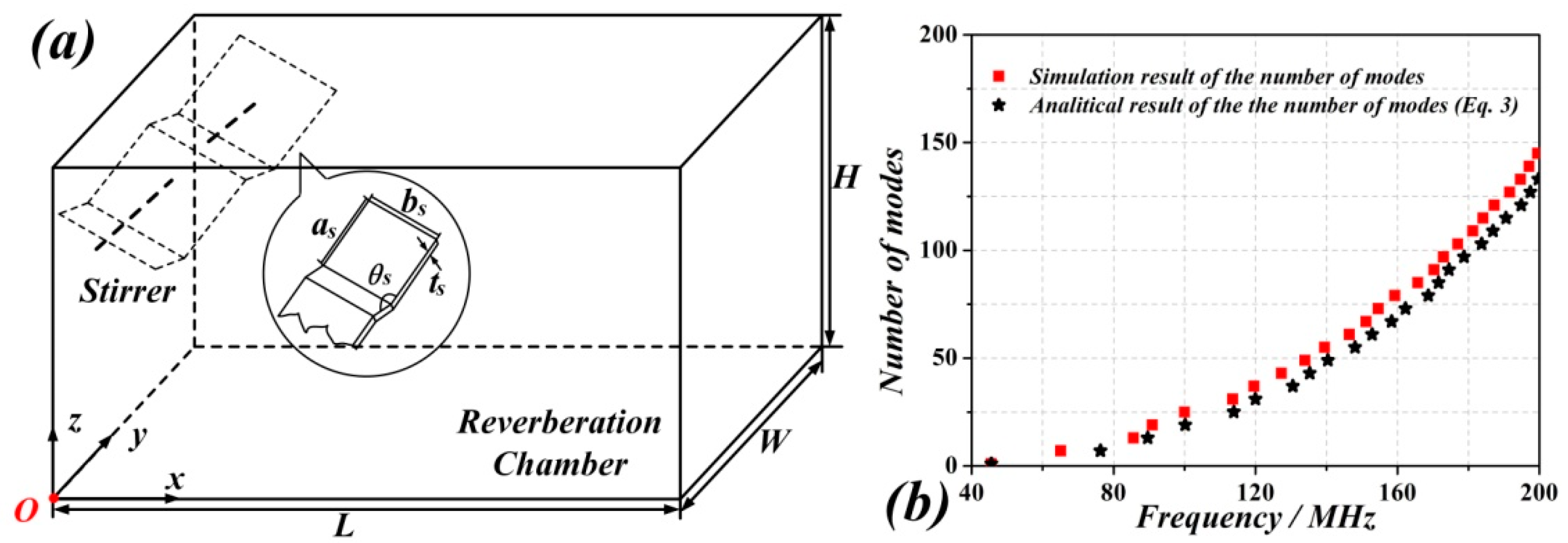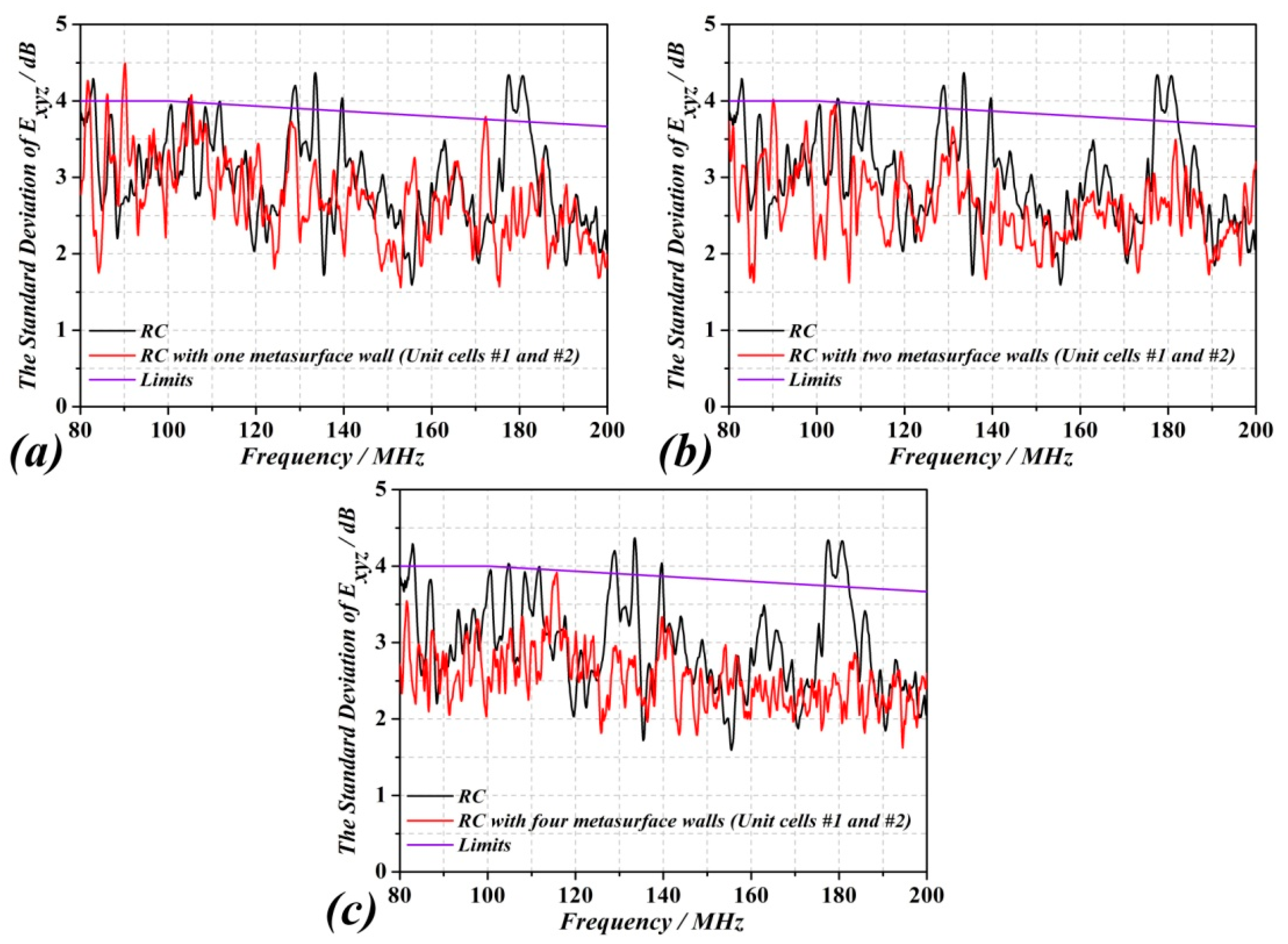Enhancing the Number of Modes in Metasurfaced Reverberation Chambers for Field Uniformity Improvement
Abstract
:1. Introduction
2. Theoretical Analysis
3. Enhancing the Number of Modes by Using Metasurfaced RCs
4. Analysis of the Field Uniformity Characteristics of the RC
5. Conclusions
Author Contributions
Funding
Acknowledgments
Conflicts of Interest
References
- Besnier, P.; Démoulin, B. Electromagnetic Reverberation Chambers, 1st ed.; ISTE Ltd.: London, UK; John Wiley & Sons, Inc.: Hoboken, NJ. USA, 2011; ISBN 987-1-84821-293-0. [Google Scholar]
- Wanderlinder, L.F.; Lemaire, D.; Seetharamdoo, D. Experimental analysis for metamaterials used to lower the LUF of a reverberation chamber. In Proceedings of the 2016 International Symposium on Electromagnetic Compatibility-EMC EUROPE, Wroclaw, Poland, 5–9 September 2016. [Google Scholar]
- Wanderlinder, L.F.; Lemaire, D.; Coccato, I.; Seetharamdoo, D. Practical implementation of metamaterials in a reverberation chamber to reduce the LUF. In Proceedings of the 2017 IEEE 5th International Symposium on Electromagnetic Compatibility (EMC-Beijing), Beijing, China, 28–31 October 2017. [Google Scholar]
- Song, J.; Li, Z.; Sun, H.; Shi, J.; Gu, C.; Wang, K. Field uniformity improvement at lower frequencies in a reverberation chamber using metasurfaces. In Proceedings of the 2018 IEEE International Symposium on Electromagnetic Compatibility and 2018 IEEE Asia-Pacific Symposium on Electromagnetic Compatibility (EMC/APEMC), Singapore, 14–18 May 2018. [Google Scholar]
- Arnaut, L.R. Compound exponential distributions for undermoded reverberation chambers. IEEE Trans. Electromagn. Compat. 2002, 44, 442–457. [Google Scholar] [CrossRef]
- Lemoine, C.; Besnier, P.; Drissi, M.H. Investigation of reverberation chamber measurements through high-power goodness-of-fit tests. IEEE Trans. Electromagn. Compat. 2007, 49, 745–755. [Google Scholar] [CrossRef]
- Li, H.; Hao, J.; Zhou, L.; Wei, Z.; Gong, L.; Chen, H.; Chan, C.T. All-dimensional subwavelength cavities made with metamaterials. Appl. Phys. Lett. 2006, 89, 104101. [Google Scholar] [CrossRef]
- Seetharamdoo, D.; Coccato, I.M. Investigation on the use of metamaterials to lower the operating frequency of reverberation chamber. In Proceedings of the EMC Europe 2011 York, York, UK, 26–30 September 2011. [Google Scholar]
- Andries, M.I.; Seetharamdoo, D.; Besnier, P. Analytical modal analysis to evaluate the contribution of metamaterials to the improvement of reverberation chambers. In Proceedings of the 2014 International Symposium on Electromagnetic Compatibility (EMC Europe), Gothenburg, Sweden, 1–4 September 2014. [Google Scholar]
- Engheta, N. An idea for thin subwavelength cavity resonators using metamaterials with negative permittivity and permeability. IEEE Antennas Wirel. Propag. Lett. 2002, 1, 10–13. [Google Scholar] [CrossRef] [Green Version]
- Caiazzo, M.; Maci, S.; Engheta, N. A metamaterial surface for compact cavity resonators. IEEE Antennas Wirel. Propag. Lett. 2004, 3, 261–264. [Google Scholar] [CrossRef] [Green Version]
- Dupré, M.; del Hougne, P.; Fink, M.; Lemoult, F.; Lerosey, G. Wave-field shaping in cavities: Waves trapped in a box with controllable boundaries. Phys. Rev. Lett. 2015, 115, 017701. [Google Scholar] [CrossRef] [PubMed]
- Kaina, N.; Dupré, M.; Fink, M.; Lerosey, G. Hybridized resonances to design tunable binary phase metasurface unit cells. Opt. Express 2014, 22, 18881–18888. [Google Scholar] [CrossRef] [PubMed]
- Dupré, M.; Fink, M.; Garnier, J.; Lerosey, G. Layer potential approach for fast eigenvalue characterization of the Helmholtz equation with mixed boundary conditions. Comput. Appl. Math. 2018, 37, 1–11. [Google Scholar] [CrossRef]
- Sim, D.U.; Kwak, S.I.; Kwon, J.H.; Park, S.O. Development and Validation of New Reverberation Chamber for Wireless Devices. Wirel. Commun. Mob. Comput. 2018, 37, 4675–4685. [Google Scholar] [CrossRef]
- Cozza, A. The role of losses in the definition of the overmoded condition for reverberation chambers and their statistics. IEEE Trans. Electromagn. Compat. 2011, 53, 296–307. [Google Scholar] [CrossRef] [Green Version]
- CISPR; Joint Task Force. A–IEC SC 77B: IEC 61000-4-21 Electromagnetic Compatibility (EMC)-Part 4-21: Testing and Measurement Techniques-Reverberation Chamber Test Methods. International Electrotechnical Commission (IEC) International Standard, 2011. Available online: https://webstore.iec.ch/publication/4191#additionalinfo (accessed on 5 September 2018).
- Orjubin, G.; Richalot, E.; Mengue, S.; Picon, O. Statistical model of an undermoded reverberation chamber. IEEE Trans. Electromagn. Compat. 2006, 48, 248–251. [Google Scholar] [CrossRef]
- Arnaut, L.R. Operation of electromagnetic reverberation chambers with wave diffractors at relatively low frequencies. IEEE Trans. Electromagn. Compat. 2001, 43, 637–653. [Google Scholar] [CrossRef]
- Arnaut, L.R. Statistics of the quality factor of a rectangular reverberation chamber. IEEE Trans. Electromagn. Compat. 2003, 45, 61–76. [Google Scholar] [CrossRef]
- Sun, H.; Gu, C.; Chen, X.; Li, Z.; Liu, L.; Martín, F. Ultra-wideband and broad-angle linear polarization conversion metasurface. J. Appl. Phys. 2017, 121, 174902. [Google Scholar] [CrossRef]
- Sun, H.; Gu, C.; Chen, X.; Li, Z.; Liu, L.; Xu, B.; Zhou, Z. Broadband and broad-angle polarization-independent metasurface for radar cross section reduction. Sci. Rep. 2017, 7, 40782. [Google Scholar] [CrossRef] [PubMed]
- Sun, H.; Li, Z.; Gu, C.; Xu, Q.; Chen, X.; Sun, Y.; Lu, S.; Martin, F. Metasurfaced Reverberation Chamber. Sci. Rep. 2018, 8, 1577. [Google Scholar] [CrossRef] [PubMed] [Green Version]
- Gros, J.B.; Kuhl, U.; Legrand, O.; Mortessagne, F.; Picon, O.; Richalot, E. Statistics of the electromagnetic response of a chaotic reverberation chamber. Adv. Electromagn. 2015, 44, 38. [Google Scholar] [CrossRef] [Green Version]








© 2018 by the authors. Licensee MDPI, Basel, Switzerland. This article is an open access article distributed under the terms and conditions of the Creative Commons Attribution (CC BY) license (http://creativecommons.org/licenses/by/4.0/).
Share and Cite
Sun, H.; Gu, C.; Li, Z.; Xu, Q.; Song, J.; Xu, B.; Dong, X.; Wang, K.; Martín, F. Enhancing the Number of Modes in Metasurfaced Reverberation Chambers for Field Uniformity Improvement. Sensors 2018, 18, 3301. https://doi.org/10.3390/s18103301
Sun H, Gu C, Li Z, Xu Q, Song J, Xu B, Dong X, Wang K, Martín F. Enhancing the Number of Modes in Metasurfaced Reverberation Chambers for Field Uniformity Improvement. Sensors. 2018; 18(10):3301. https://doi.org/10.3390/s18103301
Chicago/Turabian StyleSun, Hengyi, Changqing Gu, Zhuo Li, Qian Xu, Jiajia Song, Baijie Xu, Xiaohang Dong, Kuan Wang, and Ferran Martín. 2018. "Enhancing the Number of Modes in Metasurfaced Reverberation Chambers for Field Uniformity Improvement" Sensors 18, no. 10: 3301. https://doi.org/10.3390/s18103301




